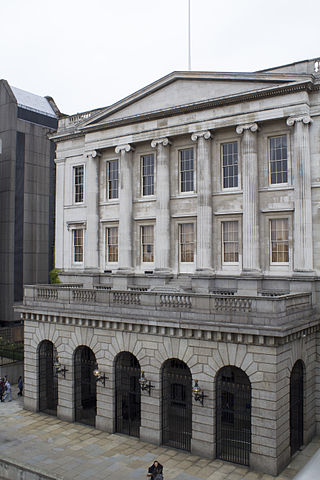
A livery company is a type of guild or professional association that originated in medieval times in London, England. Livery companies comprise London's ancient and modern trade associations and guilds, almost all of which are styled the "Worshipful Company of" their respective craft, trade or profession. There are 111 livery companies in total. They play a significant part in the life of the City, not least by providing charitable-giving and networking opportunities. Liverymen retain voting rights for the senior civic offices, such as the Lord Mayor, Sheriffs and Common Council of the City Corporation, London's ancient municipal authority with extensive local government powers.

The Worshipful Company of Scriveners is an ancient Livery Company of the City of London. Originally known as the Mysterie of the Writers of the Court Letter and, since its incorporation, as the Master Wardens and Assistants of the Company of Scrivenors of the Cittie of London [sic], the Scriveners' Company remains one of the few City livery companies continuing to influence professional standards, namely that of scrivener notary. The Company received its first ordinances in 1373 and its royal charter was granted by King James I on 28 January 1617.
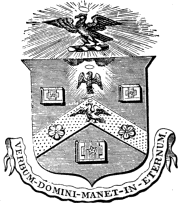
The Worshipful Company of Stationers and Newspaper Makers, usually known as the Stationers' Company, is one of the livery companies of the City of London. The Stationers' Company was formed in 1403; it received a Royal Charter in 1557. It held a monopoly over the publishing industry and was officially responsible for setting and enforcing regulations until the enactment of the Statute of Anne, also known as the Copyright Act of 1710. Once the company received its charter, "the company's role was to regulate and discipline the industry, define proper conduct and maintain its own corporate privileges."

The Worshipful Society of Apothecaries of London is one of the livery companies of the City of London. It is one of the largest livery companies and ranks 58th in their order of precedence.
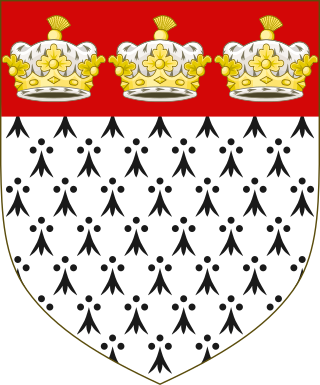
The Worshipful Company of Skinners is one of the Livery Companies of the City of London. It was originally an association of those engaged in the trade of skins and furs. It was granted Royal Charter in 1327.

The Worshipful Company of Drapers is one of the 111 livery companies of the City of London. It has the formal name The Master and Wardens and Brethren and Sisters of the Guild or Fraternity of the Blessed Mary the Virgin of the Mystery of Drapers of the City of London. More usually known simply as the Drapers' Company, it is one of the historic Great Twelve Livery Companies and was founded during the Middle Ages.
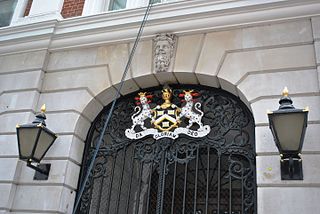
The Worshipful Company of Dyers is one of the Livery Companies of the City of London. The Dyers' Guild existed in the twelfth century; it received a Royal Charter in 1471. It originated as a trade association for members of the dyeing industry but is now mainly a charitable institution. Each year the company participates in the ceremony of Swan Upping along the River Thames.

The Worshipful Company of Leathersellers is one of the livery companies of the City of London. The organisation originates from the latter part of the fourteenth century and received its Royal Charter in 1444, and is therefore the senior leather industry-related City Livery Company.

The Worshipful Company of Painter-Stainers is one of the livery companies of the City of London. An organisation of painters of metals and wood is known to have existed as early as 1283. A similar organisation of stainers, who generally worked on staining cloth for decorative wall hangings, existed as early as 1400. The two bodies merged in 1502; the new organisation was incorporated under a Royal Charter in 1581.
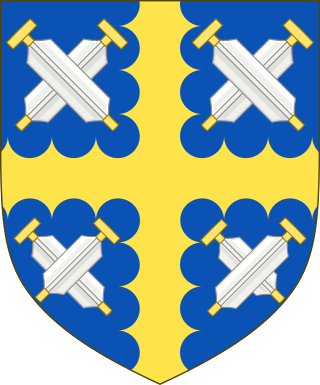
The Worshipful Company of Curriers is one of the ancient livery companies of London, associated with the leather trade.

The Worshipful Company of Coopers is one of the livery companies of the City of London. The organisation of coopers existed in 1422; the Company received its first royal charter of incorporation in 1501. The cooper trade involved the making of wine, beer, and spirit casks ; the Livery Company also functions as a charitable foundation, and supports two education establishments: the Coopers' Company and Coborn School of Upminster, Essex, and Strode's College of Egham, Surrey. The former was founded in the Ratcliffe area of London in 1536 and donated to the Company who have been involved with it ever since.
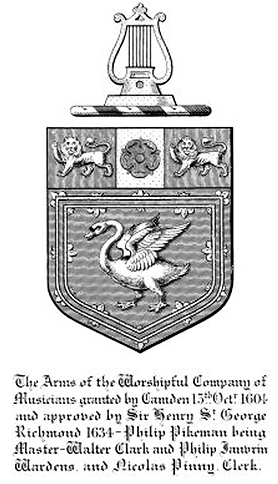
The Worshipful Company of Musicians is one of the Livery Companies of the City of London. Its history dates back to at least 1350. Originally a specialist guild for musicians, its role became an anachronism in the 18th century, when the centre of music making in London moved from the city to the West End, and for more than a century it was a general guild for figures in the city, with no specific musical role. In the late 19th century, the musical element was revived, and the modern Company promotes all aspects of the art and science of music.
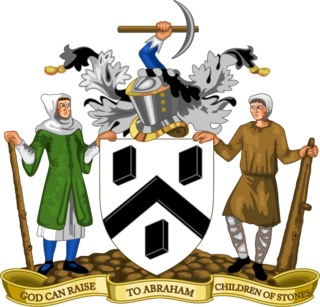
The Worshipful Company of Paviors is one of the livery companies of the City of London. The Paviors can trace their history back to medieval times; they were responsible for the paving and maintenance of London's streets. It received a Royal Charter from Queen Elizabeth II in 2004. The company is no longer a trade association for or a regulator of London's road constructors. Today, it focuses on the promotion of excellence in all areas of construction.
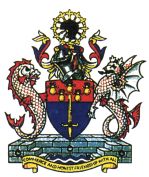
The Worshipful Company of World Traders is one of the 111 Livery Companies of the City of London.

The Trial of the Pyx is a judicial ceremony in the United Kingdom to ensure that newly minted coins from the Royal Mint conform to their required dimensional and fineness specifications. Although coin quality is now tested throughout the year under laboratory conditions, the event has become an annual historic tradition. Each year, thousands of coins are put on trial, consisting of both those struck for circulation and non-circulating commemorative coins.

Goldsmiths' Hall is a Grade I listed building at the junction of Foster Lane and Gresham Street in the City of London. It has served as an assay office and the headquarters of London's goldsmith guild, the Worshipful Company of Goldsmiths, one of the livery companies of the City of London. The company has been based at this location since 1339, the present building being their third hall on the site.
The Goldsmiths' Company Assay Office in London is the oldest assay office in the United Kingdom. The company has provided hallmarking services since The Goldsmiths Company was founded in the 14th century. The company received its royal charter in 1327 and ranks fifth in order of precedence of the 12 great livery companies of the City of London.
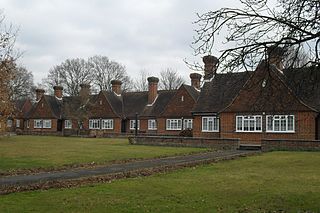
The Dyers Almshouses are a group of 30 almshouses belonging to the Worshipful Company of Dyers, a London Livery Company. Built in three stages between 1939 and 1971, they are located close to the town centre of Crawley, a New Town and borough in West Sussex, England. The distinctive Arts and Crafts-influenced buildings are arranged around a courtyard on a street close to Crawley town centre, and have been granted conservation area and locally listed building status.
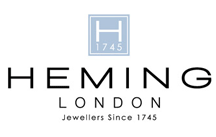
Heming is a British jewellery company, founded in London in 1745. The company has a showroom in the Piccadilly Arcade near to the original store on Piccadilly.
Arthur Girling Grimwade FSA was a British antiquarian known for his work in the history of silversmithing and goldsmithing, a field in which he was "highly respected" and a "world authority". He spent 20 years writing the reference work London Goldsmiths 1697-1837: Their Marks & Lives, which was published in 1976; he also wrote numerous other reference works and scholarly articles, beginning with a 1947 article in Country Life about items in the collection of the Ashmolean Museum.























